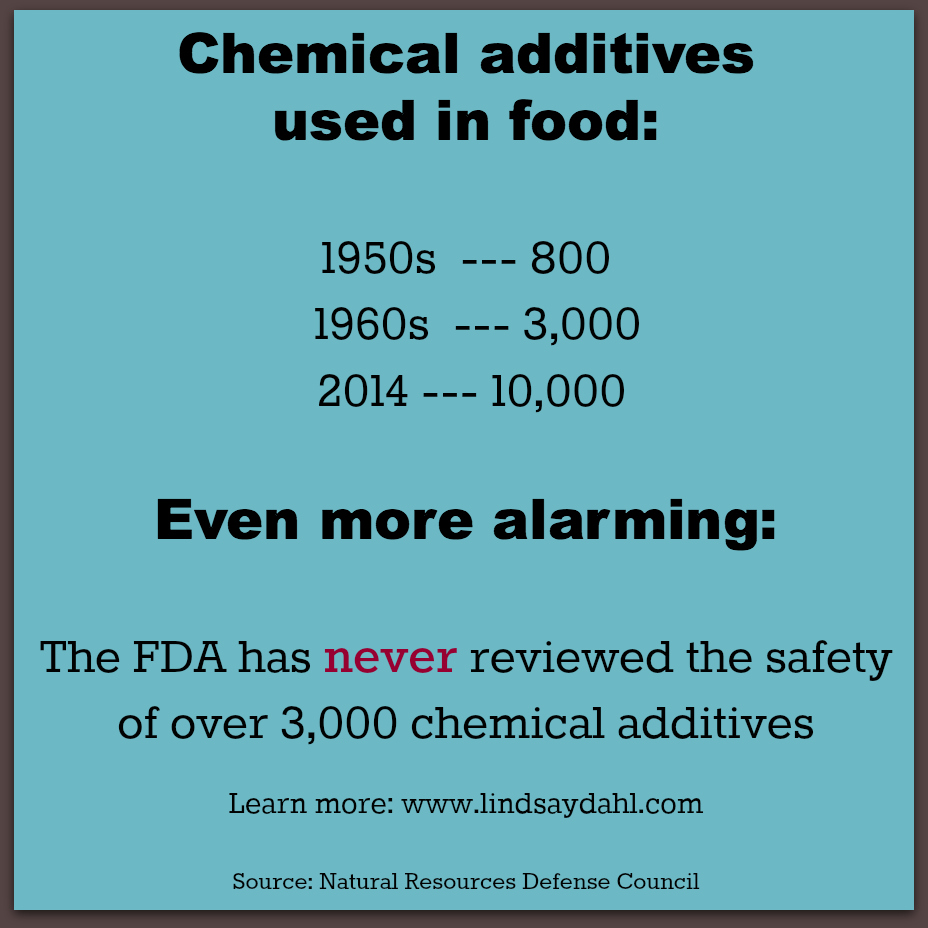Last week I wrote about a major federal loophole that has allowed unsafe chemical additives into the food we eat each and every day. The “generally recognized as safe” (GRAS) loophole, lets food companies use chemical additives on to the market and into our tummies. You can read more about the laughable “approval” process food companies need to go through to put questionable additives like MSG and aspartame in our food here.
In short, GRAS has become a new four letter word. It’s bad, it’s not appropriate for children (or adults) and grandma wouldn’t approve.
Today I want to explore the how many chemical additives in food are kept secret and the rise in additives over time. I’ve relied on the great research from the Natural Resources Defense Council (NRDC), who recently released a report “Generally Recognized As Secret.” In conjunction with this report they have produced a great video that breaks the issue down.

Chemical additive use grows rapidly over six decades
Similar to the use of chemicals in our consumer products (also unregulated and end up in our bodies) chemical additives in our food have grown exponentially. If you look back in history, it’s not hard to see how or why chemical use has skyrocketed.
The invention of new products that saved us time cleaning our homes and were considered a modern marvel. They were something to be grateful for rather than question.
Interestingly, Michael Pollan writes in his book Cooked: A Natural History of Transformation, that many women in the 1950s and 60s were interested in streamlining or exporting housework like cleaning, but were actually leery of turning the kitchen over to food companies. Packaged and processed foods weren’t welcomed with open arms as I once believed.
It wasn’t until the food companies found the perfect amount of effort that needed to go into making a processed meal plus a large advertising budget, did we start to consume and trust processed foods. Fast forward several generations and now we don’t even think twice before biting into that hot pocket or Lean Cuisine.
The problem is that along the way, we were using chemicals in our products and foods, knowing very little about their health effects. The system has gone unchecked on both accounts for decades and the public has assumed that someone was out there checking the safety of these chemicals. It would be asinine if they weren’t assessing safety, right?
They’re not.
Our chemical secrets
Chemical food additives make “convenience” foods possible. As Michael Moss unfolds in his book Salt, Sugar and Fat, most efforts by processed food companies to reduce their reliance on these three ingredients (all preservatives) and other chemicals have been an utter failure. The food tastes horrible.
NRDC’s report investigating in the dramatic rise of chemical additives in processed food, and they also discuss how many of the additives in our food are kept secret, not only from the public, but also the FDA.
Maricel Maffini PhD, from NRDC said it well,
Companies can add chemicals into our food without ever telling the FDA about their identity, their uses and (wait for it) their safety! As long as a company designates a chemical as being ‘generally recognized as safe’ or GRAS in regulatory parlance, according to FDA’s interpretation of the law, it has no responsibility to inform the agency. FDA doesn’t know about the safety of an estimated 1,000 chemicals because they aren’t disclosed.
The solution
Obviously we have a big problem on our hands.
The good news is there are a lot of great health and consumer safety organizations working on this issue.
1-Take a moment to sign a petition to the FDA asking them to reform the GRAS loophole, because until we demand action, chemical food additives will continue to be “generally considered as secret.”
2- Share this blog on social media (using the share buttons below) to spread the word.
3- Check out Part I (infographic on our broken laws) and Part III (how to avoid chemical food additives) of the series.
4- And join my mailing list to make sure you stay up to speed on forthcoming writing on the topic. It’s a weekly email full of my latest articles!




The fact that so many aren’t even on the label is very troubling to me. How can we avoid them?
That’s what part III is about! Stay tuned for next week. :)
Looking forward to it!
All the more reason to stick to WHOLE REAL food!! The closer we eat to the earth, the cleaner our food will be. Thanks for posting this. I’ll help spread the word on this to get the message out.
Thanks Lauren, it helps motivate me to focus on cooking whole food rather than turning to convenience foods!
Wow. I had no idea about these stats. Troubling, indeed. Off to sign the petition!
I know, me neither! It’s really alarming. I used to think that at least we had full ingredient disclosure on food packaging, now that’s not even true.
Thanks for the great investigative reporting Lindsay. We need to know what’s in our food!
Ooooohhhh these stats just make me cringe! I’m totally guilty of using too many pre-packaged meals and I’ve just got to get better about cooking with real food so I can save my poor kids from this chemical nonsense!
Once again, I am so frustrated that there is such little transparency when it comes to our food. Over 5,000 chemical additives are not required to appear on ingredient labels?! Thank you Lindsay for creating awareness and discussion surrounding this ugly issue.
The 5k number is what got me too…